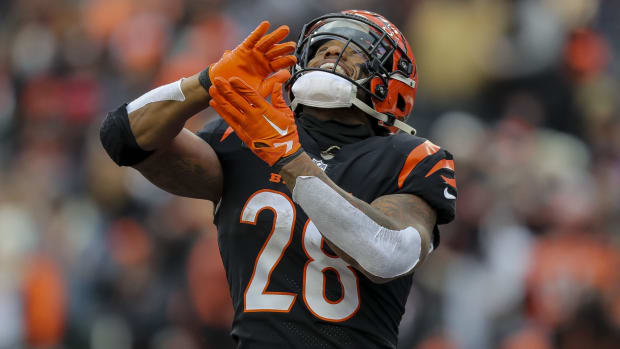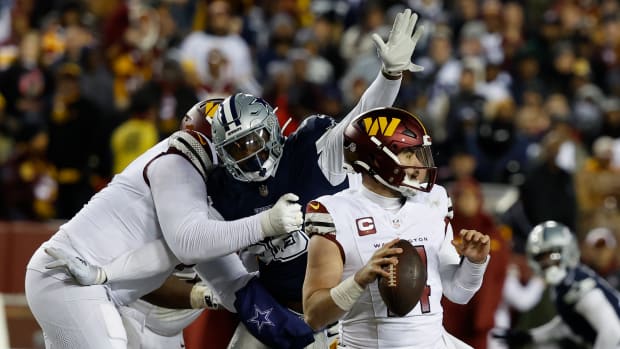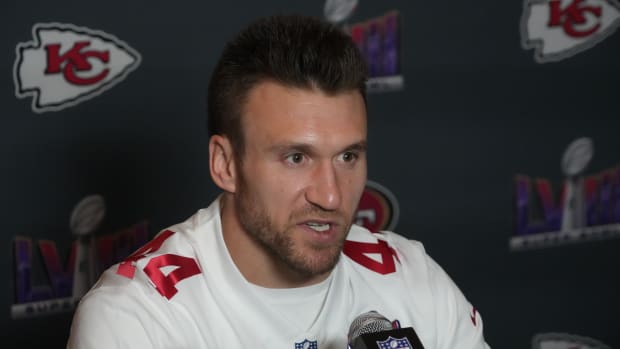
Jerry’s New World
The Cowboys broke ground in August on a new facility in Frisco, Texas. (LM Otero/AP)
FRISCO, Texas — As the sun sinks below the grasslands, a familiar ritual unfolds in this sprawling suburb 30 miles north of Dallas. Cheerleaders in beauty pageant makeup wave pompoms above their white cowboy hats. The PA announcer accentuates his play calls with y’alls. The scent of two-dollar hot dogs wafts through the stands, where fans clank first-down cowbells in seeming competition with the marching band’s deafening drum line.
In the middle section of the grandstand sits Nathaniel James, an 8-year-old with sparkling hazel eyes and a toothless grin. Wearing the Tony Romo jersey he got for Christmas last year, Nathaniel plays catch with his father on a grassy knoll during halftime. The boy already has his whole life figured out: he wants to be just like Udgam Goyal, Frisco Liberty’s varsity quarterback. Then he’ll play for Texas A&M, and then he’ll suit up for the Cowboys.
Little does Nathaniel realize: If he were to have Romo’s job some day, turning pro would mean going home.
Starting in 2016, Frisco will be the new address of the Cowboys, who broke ground in August on a $115 million facility that will feature a 12,000-seat indoor stadium and two practice fields. What makes the setup especially different from the Cowboys’ current digs—they’ve been headquartered in Valley Ranch since 1985—is a unique relationship with Frisco’s school district, one of the fastest growing in the country.
“My vision is that one day, Tony Romo will walk off the field to the west after practice,” Jerry Jones says, “and a high school quarterback will walk on the field from the east the minute Tony leaves.”
Frisco’s seven high school football teams will have access to the facility, practicing and playing games on the same turf upon which DeMarco Murray, Dez Bryant and Jason Witten go to work every day. They’ll share the same film rooms, training rooms and weight rooms. The grounds will also be used by the schools’ soccer teams, and journalism students will have access to state-of-the-art media studios. But at its core, the deal allows Jerry Jones—the mastermind behind the $1.2 billion palatial AT&T Stadium—to bring America’s team back to its roots with Friday night lights.
“My vision is that one day, Tony Romo will walk off the field to the west after practice, and a high school quarterback will walk on the field from the east the minute Tony leaves,” Jones says. “That vision, that marriage of the Cowboys and Texas high school football, has been a driving force for me.”
Not so long ago, few could have imagined such a pairing. When David Kuykendall was hired as the high school football coach in 1993, Frisco was a farm town. There were 6,000 residents, one elementary school, one middle school and one high school. “The high school, you’re talking about 600 kids—at most,” says Kuykendall, now Frisco’s district-wide athletic director. “The town was the definition of rural America.”
Main Street once had nothing but a Double Dip Frozen Custard drive-through, a post office and plenty of cow stables. The pastel-painted custard shop is still serving customers, but it’s nestled in a downtown area overrun with salons, banks, a cupcake shop, a Thai restaurant, cafes, a minor league baseball park, the Dallas Stars’ NHL training facility, boutiques, lawyers’ offices, steak houses, pizzerias and a gourmet popcorn store.
Starting in 2000, the Dallas-Forth Worth metroplex grew exponentially, increasing by 1.3 million people (25%) over nine years. Frisco, its land cheap and undeveloped, was the fastest-growing city in the United States during that span. The town built a second high school in 2003, and six more over the next 11 years. A population of 141,550 is expected to max out at 300,000 over the next decade, with an anticipated 13-14 high schools, 20 middle schools and 60 elementary schools serving the community.
Frisco Memorial Stadium under an October sky. (Emily Kaplan/The MMQB)
High school football is currently played at Frisco Memorial Stadium, an 8,000-seat venue built in 1986, and Toyota Stadium, a 117-acre complex that is home to FC Dallas of Major League Soccer. (When Lamar Hunt built his stadium in 2005, he wanted the schools to latch on in hopes of promoting soccer in the community, a model the Cowboys are imitating.) Needless to say, a third stadium was needed, so the $30 million the school district had proposed spending on its own outdoor stadium will be applied to the Cowboy’s 66-acre multi-use complex. “Everything is going to be done first-class,” Romo says. “Those kids that get to share that facility with us are going to be very fortunate. This is a really unique idea and a concept that no one else has come up with.”
“On the field the NFL is a copycat league, and I’m not sure it’s different off the field,” says Stephen Jones, the team’s executive vice president (and Jerry’s son). “I’m sure people will be intrigued with what we’re doing here. It wouldn’t surprise me a bit if you look up one day and there’s more of this.”
The Cowboys will be contractually obligated to hold training camp in Frisco for at least one week each season, and they’ll also pick up all annual maintenance costs (turf replacement, for example, runs at least $500,000 every eight years or so). “Consider maintenance costs for scoreboards, video boards, audio systems,” says Jeremy Lyon, Frisco’s superintendent of schools. “The turn of investment for us will happen very quickly.” When the Cowboys aren’t in town, the school district will have full run of the place; it can hold graduations or let marching bands practice indoors (a coup since the state competition is held in the Alamodome).
“High school athletics, especially down here in Texas, is an arm’s race,” says Vance Gibson, the football coach at Frisco High. “Everyone wants bigger and better. Well, right now in Frisco, we’re in a position where our kids can have that first-hand. They are literally going to experience the best environment, best facilities, best opportunities possible. As a parent, as a coach, what more could you want?”
Just this month, Frisco was named “the best place in Texas for young families” by the consumer advocacy website NerdWallet.com. As Nathaniel lobbed 10-foot spirals to his father during halftime at Frisco Memorial Stadium last Friday, the scene played out like a promotional video. One ball missed its target and bounced down a hill, the boy chasing after it all the way down to field level. Breathless after making the climb back up, he flashed that toothless grin and told his dad, “This is the coolest stadium ever.”
Just wait until he sees Romo walking off the new field in a few years.
[widget widget_name="SI Newsletter Widget”]







































